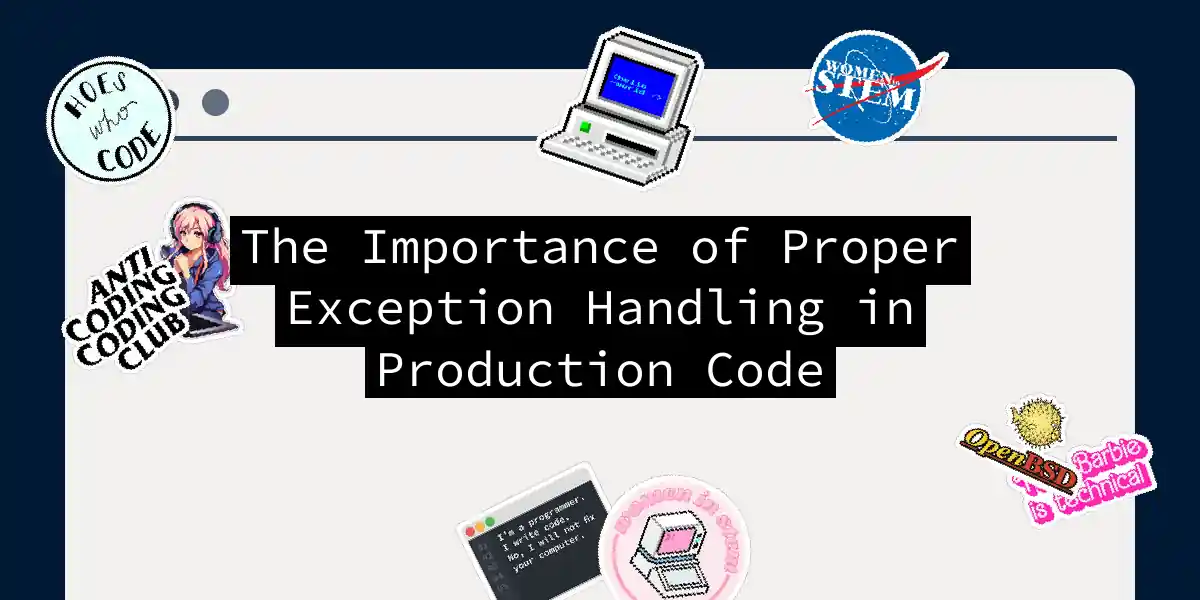The Importance of Proper Exception Handling in Production Code
When coding, we often find ourselves in a world where everything is expected to go smoothly, but in reality, it’s more like navigating a minefield. Exceptions are those unexpected events that can turn your perfectly crafted code into a chaotic mess if not handled properly. In this article, we’ll delve into the importance of exception handling, why it’s crucial for your production code, and how to implement it effectively.
What are Exceptions?
Exceptions are anomalous or exceptional conditions that require special processing, often changing the normal flow of program execution. They can arise from various sources such as invalid user input, code errors, device failures, network connection losses, or even something as simple as attempting to divide by zero.
Why is Exception Handling Important?
Exception handling is not just a nicety; it’s a necessity. Here are a few reasons why:
User Experience
Imagine a user trying to perform a critical operation, only to be greeted by a cryptic error message like “Object not set to reference of an object.” This is not only frustrating but also unprofessional. Proper exception handling allows you to present a friendly error message, guiding the user on what to do next. For instance, instead of a technical jargon, you could display “There has been an issue. Please contact the helpdesk”.
Code Maintainability
Exception handling makes your code more maintainable. By separating error handling code from the normal flow of your program, you make it easier to debug and maintain. This separation helps in embedding input specifications into the code, reducing the need to look up the design documentation every time you need to make changes.
Security
Unhandled exceptions can leave your application and underlying system in a vulnerable state. Properly handling exceptions ensures that sensitive information is not exposed to potential attackers. For example, instead of displaying the full error message, you can show a generic error message to the user while logging the detailed error for internal use.
Types of Exceptions
Exceptions can be broadly categorized into two types:
Checked Exceptions
These are also known as compile-time exceptions. The compiler checks for these exceptions during the compilation process to ensure they are handled by the programmer. Examples include SQLException and ClassNotFoundException. If these exceptions are not handled, the compiler will throw an error.
Unchecked Exceptions
These exceptions are not checked by the compiler and can occur at runtime. Examples include IllegalStateException, IllegalArgumentException, and NullPointerException. These exceptions are typically used for programming errors that a well-written application should not encounter.
How to Handle Exceptions
Try-Catch Blocks
The heart of exception handling lies in the try-catch blocks. Here’s a simple example in Java:
try {
// Code that might throw an exception
int result = 10 / 0;
} catch (ArithmeticException e) {
// Handle the exception
System.out.println("Cannot divide by zero!");
}
Try-Finally Blocks
The finally block is used to ensure that certain code is executed regardless of whether an exception is thrown or not. This is particularly useful for cleaning up resources.
try {
// Code that might throw an exception
int result = 10 / 0;
} catch (ArithmeticException e) {
// Handle the exception
System.out.println("Cannot divide by zero!");
} finally {
// Code to clean up resources
System.out.println("Cleaning up resources...");
}
Global Exception Handlers
Global exception handlers can be useful for logging exceptions and providing a generic error message to the user. However, they should not be used to keep the application alive in an inconsistent state.
Best Practices for Exception Handling
Keep it Simple and Clear
Avoid overusing try-catch blocks. Instead, use them judiciously to ensure code clarity and resilience. Here’s an example of how to handle exceptions in Ruby:
begin
do_something_that_might_not_work!
rescue SpecificError => e
do_some_specific_error_clean_up
retry if some_condition_met?
ensure
this_will_always_be_executed
end
Log Exceptions
Logging exceptions is crucial for debugging. Ensure that your logs contain enough information to help you understand what went wrong.
Avoid Blindly Displaying Exceptions
Never display raw exception messages to users, as they may contain sensitive information. Instead, use a UserSafeException type with a UserMessage property that contains safe information for the user.
try {
// Code that might throw an exception
int result = 10 / 0;
} catch (ArithmeticException e) {
UserSafeException safeException = new UserSafeException("Cannot divide by zero!", e);
System.out.println(safeException.getUserMessage());
}
Conclusion
Exception handling is not just about catching and throwing exceptions; it’s about ensuring your application remains robust, secure, and user-friendly. By following best practices and using the right tools, you can turn what could be a disaster into a minor hiccup. Remember, exceptions are not the enemy; they are your allies in making your code better.
So the next time you encounter an exception, don’t panic. Instead, see it as an opportunity to improve your code and provide a better experience for your users. After all, in the world of coding, exceptions are just part of the journey, and handling them properly is what sets the pros apart from the rest.
